Musings
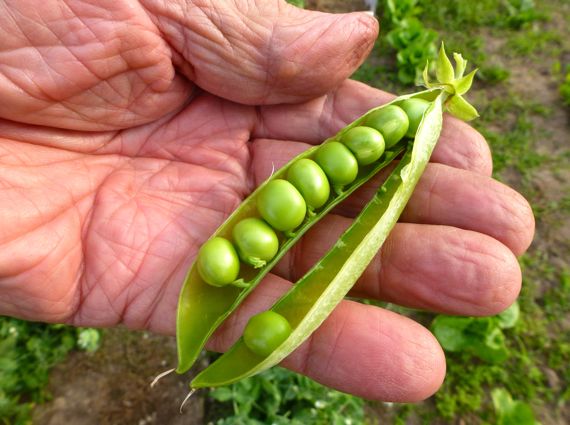
Before we left, I helped The Botanist with some chores. I had the most fun looking for the earliest fresh peas (English peas, they call them in the Deep South, to distinguish them from field peas). We also removed a few old dead raspberry canes from the plants Gail gave Dad the fall he had the triple bypass surgery, cut off canker infested limbs from the plum tree, and checked out the basil that I germinated and Dad transplanted into his garden.
Posted at 10:22 PM |
2 Comments »

I’m not sure what a Michigan firm (Meijer) is doing promoting an Alaska-based flavor name (the Denali part)…and curious about what Moose Tracks Tee-Em Fudge might really taste like…although the phrase sounds better than Muddy Footprints Fudge (with or without the Tee-Em—and yeah, I know it says Arr, but that doesn’t have the same ring).
Those with long memories may recall that long ago in another lifetime I was a Meijer employee, although then it was Meijer’s Thrifty Acres and Old Fred was still alive.
Posted at 9:59 PM |
1 Comment »
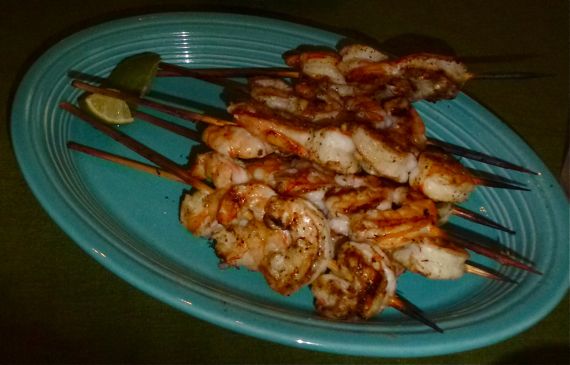
Shrimp from the barbie makes a party!
Posted at 9:28 PM |
1 Comment »

I moved outside of my comfort zone today. I made pasta.
I checked the three cookbooks I have with pasta recipes and figured I could use AP or cake flour, but the best would be semolina.
And the Bob’s Red Mill selection at the nearby WF did include the semolina, so that’s what I used. I dumped it on the counter and immediately got worried. The flour was not fine; it was grainy.
I added the liquids using the well method, and started working the dough. Still grainy. Then, all of a sudden it wasn’t! I was thrilled.
I just want to say, however, that if the quantity is right for Italians with three cups of flour for four people in a side dish of pasta, we need maybe one or one-and-a-half. There was w-a-y too much.
But tasty!
Posted at 10:22 PM |
Comments Off on Adventures in the flour aisle
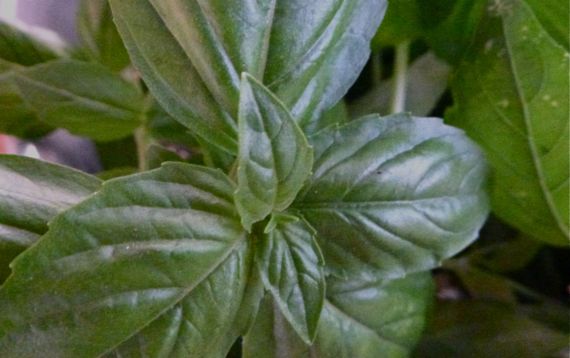
We initiated the 2011 basil harvest today. I made pesto and combo’d it with Japanese noodles, however incongruous that is, because that’s what I had in the pantry. Yum!
Posted at 8:15 PM |
4 Comments »
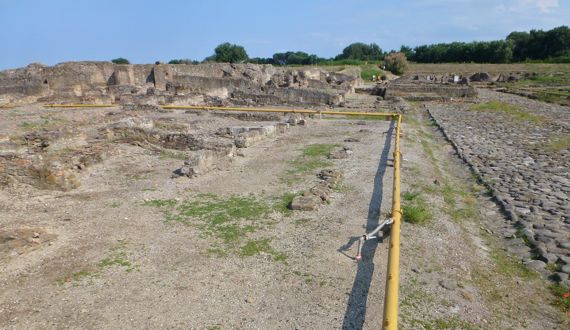
“There’s an archaeological site,” Someone Else said, “let’s stop.!”
And thus we had a wonderful guided tour of Sybaris—to the Greeks, or Copia—to the Romans. We saw the ruins of Copia, except for a stretch of the Greek’s road. (Read the Greek community’s history here.
You’re looking SSE toward the Roman center-of-town, which had a large circular city fountain, the theater, and at least one temple.
Apparently the coast side of Copia had a harbor and city gate, but the sea is now several hundred meters away. I guess sediment from the mountains washed down over the ruins protecting wall bases and floors, as well as the roads.
I’m not sure of the hydrology, but we saw and heard two busy pumps, keeping the water at bay. One place we could see the current water level, nearly 2m below the road—so the pumps must run continuously to keep the site from flooding—at least during rainy periods—and we experienced that recently. The yellow pipe is part of the water-removal system.
Thus, we have left Sicily, and are doing a quick perusal of the Ionian coast (Jonian is the spelling here). The B&B we stayed at hooked us up with a local Calabrian restaurant, and we dined with two French couples staying at the same B&B—a linguistic olympics for all of us, as we switched among French, English, and Italian, especially to discuss the foods we were eating. John used Google translate several times; for example, you gotta really know a language to know “white mulberry*” (Morus alba) in it—they were raw, fresh, sweet, and part of the fruit course along with dark, sweet cherries. Yum.
The white mulberries are probably a legacy of the silk industry. A town up the way, Catanzaro, was known historically for its velvet, silk and other textiles; I’m guessing that’s the link to the Morus alba trees….
* mûre
Posted at 10:22 PM |
Comments Off on Our sybaritic day
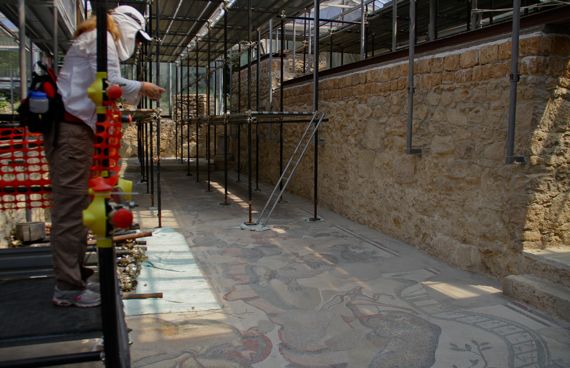
Always, the tricky thing about archaeological finds is “saving” them. Stabilizing whole residential complexes of wall bases and Roman mosaic floors here at the Villa Romana del Casale is a major engineering project. I’m still amazed that conservators let you walk on some of the floors—on mosaic fragments. However, huge protective roofs and elevated walkways for the tourists are transforming this hillside into what looks like a series of greenhouses from afar. The corollary is that often shadows make study of the figures and designs in the mosaics, umm, difficult. And superheated.
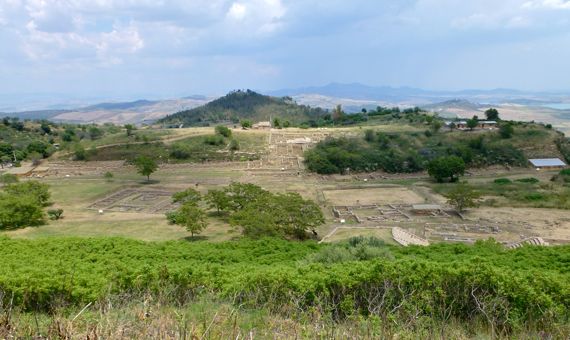
The lower zone of Morgantina includes the agora, stoa, granaries, and stores—a wide variety of special-use architecture, while the long-ago Greeks (well, their slaves) built residential architecture on the distant hilltop and the one I’m standing on, overlooking the core area of the settlement. The size of the bouleterion, or steps where citizens sat when they met to deliberate about community business, indicates Morgantina had a substantial population—and this was the mid-400s BC. And, yes, that’s a theater just peeking out from the vegetation in the right foreground.
Note how from this city, the residents could monitor activity over a wide area below. Note that their gleaming buildings could likewise be seen from a huge surrounding area.
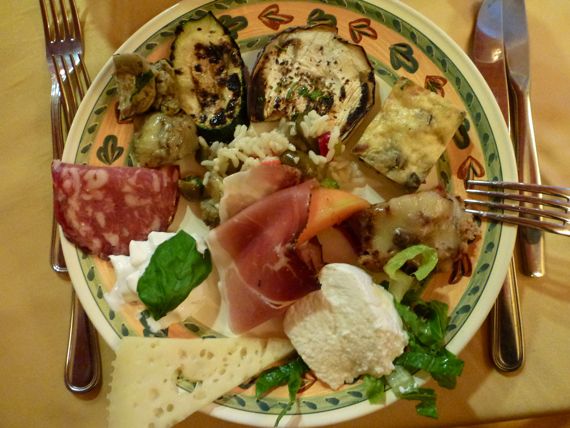
Here’s a sample of the good eats we’ve been enjoying—the antipasti we had tonight—two meats, three cheeses, an egg omelette(?), a cold rice salad, three veg, and a breadcrumb-stuffed red pepper. The meatloaf that arrived several courses later was tender and outstanding, with just a tiny bit of finocchio selvatico (wild fennel) as part of the flavoring, I was told. I guessed mint, but that’s probably because I know the Italian for it (menta), and I thought the flavor similar.
My vocabulary widens—slowly.
I am full. And that is all. (Hat’s off to KW for this style of sign-off.)
Posted at 3:53 PM |
2 Comments »

View ENE from cliffs above Castellammare del Golfo (Yes, the water is really that color). See the terrain in Google Maps by clicking here. Note that there’s a fortress-castle on the point that closes in CdelG’s harbor.
I did not understand how rugged the coasts of Sicily are. This is the NW corner of the island, looking back to the east. On the headland in the distance (left rear) is Palermo’s airport.
Notable facts from today, in no particular order:
- We are now a traveling duo, having said a heartfelt goodbye to our fine traveling companions at that same airport.
- We saw our first Prius in Italy, a shiny black one, arriving at the airport two cars ahead of us.
- Castellammare del Golfo was the port town for Segesta (37.94068,12.83426), which in ancient times controlled travel through the pass inland from Castellammare toward population centers in the SW part of the island.
- We did learn some lessons in the high art of snacking from F, although we did very well on our own today scoring a black-olive laced baguette to go with tiny mozzarelle spheres from the SISA up the road.
- Up by San Vito lo Capo we saw an abandoned tuna factory, including a net management area and housing for the fisher-dudes. The owners closed it in the late 1960s.

- We saw evidence of recent land speculation near San Vito lo Capo, across a bleak ocean-view terrain, partly cleared of its rocks (that’s a bulldozer out there), with boundary walls marking lots. Normally, we have seen unfinished or only partly occupied apartment buildings as evidence of the same over-development. For over a kilometer here, all we saw were stone walls, no houses, no gates, even.
- We begin our migration east and north tomorrow.
* “Blu” is Italian for blue.
Posted at 12:19 PM |
1 Comment »
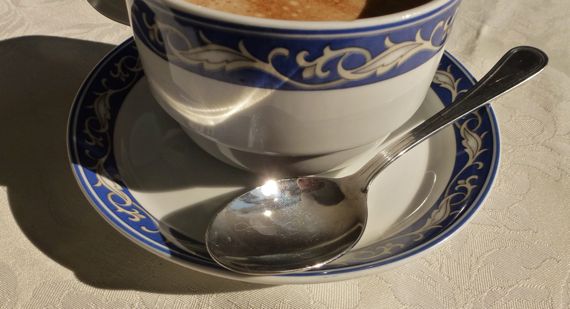
Morning one, in Pompei, I became a coffee drinker again. Especially with latte caldo—hot milk.
Posted at 3:16 AM |
3 Comments »

If you watch much of the Food Network, ya gotta expect to swoon over French food; and, indeed I wondered what AirFrance would serve us.
Turns out it was all beige food, way short on green vegetables. In the lower right, a cold tuna-rice salad with a few black olives and cubes of pickled pepper for color (the appetizer), in the middle a roll and Tillamook cheese (mozzarella), in the lower left the entree—salmon bits with buttery mashed potatoes (parmentier, they called it; WikiPee says it’s named for Antoine-Augustin Parmentier [1737–1813], an agronomist who fancied, and promoted, potatoes)—yummy, but short on nutrition. Rounding out the beige French meal, rice pudding in the upper right—made with whole milk so you know it’s tastee!, and cranberry orange yellow cake, upper left, to finish! Bracketing the meal: white wine and water.
UPDATE from the next day: Interestingly, the meal we got on the next flight, a light lunch, was positively impressive. A teeny pancake with some yummy veggies on top, crowned by a teensy scallop, pate on a square of whole-wheat bread, camembert cheese and a whole grain mini-baguette, a barley/raisin concoction that was yummy and foreign, and a mini custard tart. Still no raw veg, and short on veg in general, but not blond and truly yummy.
Posted at 10:22 PM |
Comments Off on Blond but not bland












